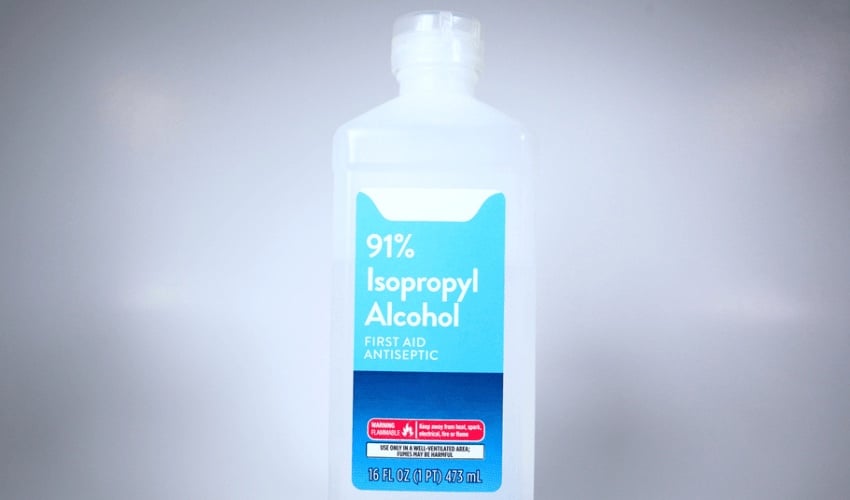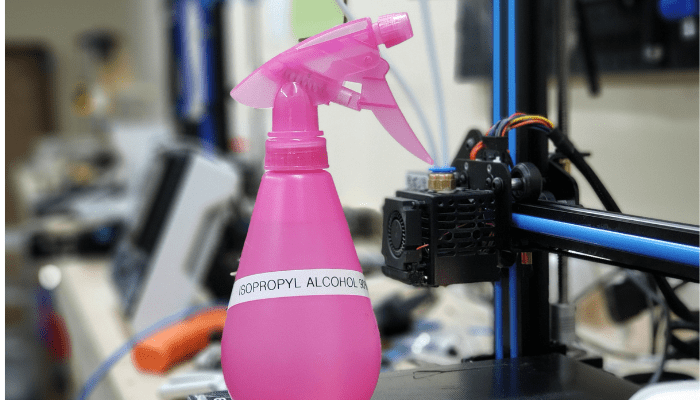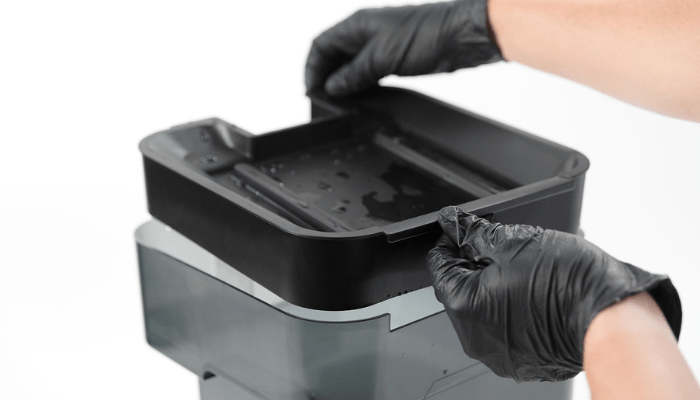Why Use Isopropyl Alcohol (IPA) in 3D Printing

When just starting out with a resin 3D printer, it is important to be well-informed, not only about the various options available, but also about the tools needed to optimize prints. From material selection to practical advice, our site has a wealth of articles to help you every step of the way, from model design to post-processing.
Today, we would like to highlight a key element: isopropyl alcohol. Used by professionals and beginners alike, this ally plays an essential role in 3D printer maintenance and print cleaning. Let’s take a look at its characteristics, advantages and limitations.
What Is Isopropyl Alcohol and What Is It Used For?
Isopropanol, or isopropyl alcohol (IPA), with the chemical formula (CH3)2CHOH, is a transparent liquid that evaporates rapidly without leaving any trace. It is made from acetone or propylene treated with sulfuric acid.
Mainly used as a solvent for sticky substances such as oils, rubbers and resins, it is also used to produce acetone and other chemical compounds. It is also used to extract certain alkaloids and to manufacture cosmetics, such as creams, lotions and perfumes.
Isopropyl alcohol is also used as a dehydrating agent, antifreeze and antiseptic in medical applications. Thanks to its compatibility with electronic and electromechanical materials, it is frequently used to clean printed circuits, magnetic heads, optical devices, rubber rollers and disk drives.

Photo Credits: r/3Dprinting, Reddit
What Are the Applications of IPA in 3D Printing?
Isopropyl alcohol (IPA) is used for the post-processing of 3D printed resin parts, made with technologies such as SLA and DLP. It is used to clean the printers and maintain the equipment, while guaranteeing a meticulous finish for the models. After printing, the post-processing process generally follows the same steps: first, the model is washed to remove excess uncured resin, then it is cured to finalize the polymerization, which is only partial during printing.
Resin prints always require supports to be produced accurately. The use of a solvent, such as isopropyl alcohol, is therefore essential to remove them cleanly. In addition to this, IPA helps to remove any residue from uncured resin on printed models, build trays and resin vats. Many manufacturers offer combined washing and curing solutions, using IPA or other solvents, enabling users to finalize polymerization and automate post-processing.
Isopropyl alcohol can be used neat or diluted, for example by mixing 70% alcohol with 30% distilled water, for optimum results. Its rapid drying makes it an effective solvent, facilitating cleaning of the printing plate and model in the event of material residue.
How Is Isopropyl Alcohol Used?
To Clean Models
Resin 3D printed parts must be washed to remove excess material, otherwise they will remain sticky and unsuitable. Post-processing with isopropyl alcohol is therefore important for good results.
To clean effectively, immerse the parts in the solvent and shake gently. It is advisable to wash them before removing the supports. For complex models, a syringe can be used to remove the resin inside and prevent it from blocking the channels. Sometimes, two washing cycles are required for a complete cleaning. Finally, it is advisable to rinse the parts with water before finishing them, ensuring that the resin is removed by the solvent.
Cleaning Printers: Inside and Out
To ensure quality prints and preserve the condition of the resin vat, thorough cleaning of the inside and outside of the 3D printer is essential. On the inside, it is important to keep the top and bottom surfaces of the film clean by removing cured resin and debris left over from printing. During this step, it is advisable to wear gloves to avoid any skin irritation caused by the resin. If the resin comes into contact with the skin, immediately rinse the affected area with soap and water.
Do not use IPA or other solvents on the inner surface of the flexible film inside the tank. It is important to check that the liquid resin has not accumulated or hardened between the layers of film. To clean the underside of the film, the liquid resin must be emptied into an opaque container. Then place the container upside down on a clean, flat surface. Use a Pec Pad with a little IPA to remove any residue.
For the outside of the tank, a paper towel is all you need to clean the remaining resin. Be sure to keep the sides of the tank clean to prevent the resin from touching the underside of the film, which could cause printing errors or damage to the roll holder. Following these instructions will preserve the tank, improve print quality and prevent damage to the printer.

This photo shows the solvent replacement process (photo credits: Formlabs)
Alcohol Purity and Price
When choosing isopropyl alcohol, it is important to check its purity. All alcohols have different levels of purity, and the alcohol sold in supermarkets, often at 30%, is not suitable for technical applications. So it’s best to avoid it.
Instead, opt for isopropyl alcohol with a purity of 95% or more. Reliable sites such as Amazon and other online retailers offer isopropyl alcohol in 1-liter bottles or 5-liter cans for better value. The price of isopropyl alcohol varies, from $5 for 500 ml to around $30 for 5 liters, depending on quantity and brand.
Health Warnings
Isopropyl alcohol is an excellent solvent, but it is also a hazardous chemical if inhaled or ingested. It can cause eye and respiratory tract irritation, and affect the central nervous system. At high concentrations, well above occupational exposure limits, it can cause severe symptoms, such as loss of consciousness. Prolonged or repeated exposure can also dry out and crack the skin, especially in cases of direct and continuous contact. In addition, dispersion or spray application can rapidly reach dangerous levels in the air.
If you use this alcohol, it is important to take precautions: wear gloves and a mask, and work in a well-ventilated area or under a fume hood. As it is flammable, if skin or clothing comes into contact with the pure substance, rinse skin immediately and remove contaminated clothing. In case of contact with eyes, rinse with plenty of water for several minutes.
Apart from these precautions, there is no reason to panic: this is a regulated product which, if used correctly and according to label instructions, presents no health risk.
Alternatives to Isopropyl Alcohol
Some manufacturers, depending on their preferences, product performance or usage habits, opt for cheaper and more effective solutions than isopropyl alcohol. Some also choose 95% or 90% ethyl alcohol, while others prefer acetone, available in supermarkets. Pink alcohol, although sometimes used by some, is not recommended by most manufacturers as it can stain prints.
A 99.9% version of pink alcohol may be an alternative, but is not available in supermarkets. Others recommend using soap and water to clean machines, although this does not always guarantee perfect resin cleaning.
Formlabs also offers tripropylene glycol monomethyl ether (TPM) as a good option for cleaning resin from parts made from non-biocompatible materials. This solvent has a mild odor and, above all, is non-flammable.
If you want to be even safer, you can use special solvents called “resin cleaners.” These are often made by the same companies that produce 3D printing solutions.
Disposal
However, if you decide to use isopropyl alcohol, you should be aware that it is an environmentally harmful material and must be disposed of properly. To dispose of isopropyl alcohol, it is therefore necessary to contact a waste disposal company. The bottle, generally made of plastic, can be disposed of in the special waste collection.
Isopropyl alcohol can also be recycled. In this video, you’ll find a useful guide on how to filter it of resin particles and reuse it efficiently.
Do you use isopropyl alcohol for your prints? Let us know in a comment below or on our LinkedIn, Facebook, and Twitter pages! Don’t forget to sign up for our free weekly Newsletter here, the latest 3D printing news straight to your inbox! You can also find all our videos on our YouTube channel.








I use alcohol lens wipes to clean the PEI printing surface on my FFF machine. It removes fingerprints and allows better part adhesion. It is simple and effective.